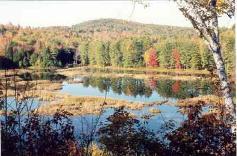|
--What is a wetland?
--What does the wetland map show?
--Why are wetlands important?
--What threatens wetlands?
--What do we need to know about wetlands in Plainfield?
--What is next?
What is a wetland?
All wetlands share three characteristics which are used to define them. The first is hydrology, the presence of water. Wetlands form wherever water is present for extended periods during the growing season. Water may be present on the surface or the soils in an area may be saturated for a sufficient period of time to develop the second characteristic of a wetland, hydric soils (Appendix F). The third characteristic is the presence of wetlands vegetation (Appendix G). Plants which are adapted to low oxygen, saturated soil conditions have a competitive advantage in wetlands and therefore become the most predominant species growing in that area. If greater that 50% of the plant life in a given area is wetlands vegetation then that area is considered to be wetland. Wetlands include swamps, bogs, marshes, and similar areas.
What does the map show?
Resource |
Data Source |
Measurement |
Wetlands |
National Wetlands Inventory |
1044 acres |
Hydric Soils |
NH Soils Map |
4212 acres |
Stream & River Shoreline |
|
371 miles |
The wetland map provides “course-filter” data for use by Town residents and groups. They identify the general locations of larger wetland areas and can be used to calculate approximate dimensions and acreages for those areas. In addition, the interconnectedness of our water resources -- watersheds, streams, ponds, wetlands, and aquifers – is shown quite well using the existing data. While this type of information can be very useful for planning purposes, none of the data is site-specific. Consequently, no site or parcel specific conclusions can be drawn. Any board recommendation or Town action will require an on-site evaluation which may include an examination by a certified specialist.
Why are wetlands important?
- Wetlands provide habitat for nearly 140 of New Hampshire’s 400 plus wildlife species as well as serving as critical feeding, spawning, and brood rearing habitat for many fish species.
- Wetlands purify our water by absorbing excess nutrients (such as phosphorus and nitrogen), by slowing the flow of water and trapping sediments, and by minimizing the impacts of storm runoff and erosion.
- Wetlands provide flood control benefits by acting as natural ‘sponges’ during heavy precipitation, thus preventing downstream flooding.
- Wetland vegetation prevents bank and shoreline erosion by binding the soil with roots and absorbing the force of wave action.
- Wetlands provide many opportunities for recreation and outdoor education.
What threatens wetlands?
The primary threat to wetland areas comes from unregulated development. These threats may include failing septic systems, construction sites which do not use best management practices to protect the surrounding environment, and other pressures created by population increases. Other threats included the over-use of fertilizers and chemicals on lawns and fields, lack of adequate vegetative buffers between developed areas and wetlands, and more specific ‘point-source’ pollution sites such as underground oil tanks at or near the wetland borders. In addition, in Plainfield, a number of wetland areas are adjoined or bisected by state highways or town roads which increase their vulnerability to pollution from accidents, road salt or poor management practices. Appendix W3 outlines the agencies and regulations which are designed to mitigate these threats.
What do we need to know?
Any additional analysis will require the accumulation of more specific data about the Town’s wetland areas. Evaluations of wetland plants, animals, invertebrates, or hydrology will require the employment of scientific specialists and funding through the Town budget, the Conservation Commission, or grants. More specific mapping of wetlands or vernal pools would provide opportunities to involve Plainfield and KUA students, but it would also require landowner permission and Town support. Ultimately, tasks such as creating maps from the gathered data, geo-referencing wetland location information with town parcel data, and building data sets for planning analysis would require outside expertise and/or supervision. However, these types of specific studies would provide base-line data from which future changes could be measured; they would be invaluable to the Town as we plan for future development.
Setting Priorities -- what’s next?
Many different studies could be undertaken, including those listed below:
- An evaluation of Town wetlands to identify specific plant and wildlife species which are supported.
- A wetland evaluation to determine the overall health of our wetlands and to determine which, if any, need special protections and/or should be given priority in our conservation efforts.
- Identify wetlands areas to be evaluated using the Method for Comparative Evaluation of Nontidal Wetlands in New Hampshire to determine which, if any, of the wetlands should be designated as ‘Prime.’
- Identify smaller wetland areas to include vernal pools and make recommendations regarding the protection of these areas.
- Accurately map existing wetlands in Plainfield using GIS resources.
|



